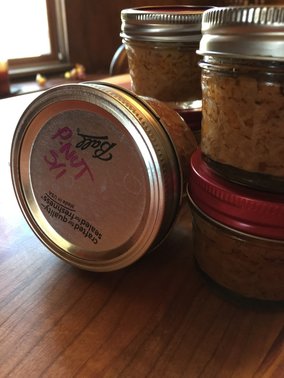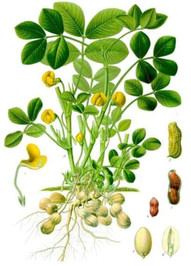How it works: Due to peanut oils high amount of monounsaturated (good) fat, and low amount of saturated (bad) fat, it is believed to prevent heart disease. However, studies show it also clogs arteries, and, would instead, increase the risk. Allergies: Peanut oil can cause serious allergic reactions to those who are allergic to peanuts, soybeans and other members of the Fabaceae plant family. Be sure consult with your allergist/physician before consuming if you suspect an allergy or are allergic to other plants within the same family. In the US, refined peanut oil is exempt from allergen labeling laws. See new guidelines on peanut allergy prevention following the recipe to learn more. -Information from Natural Medicine Database Peanut versatility as Food: The possibilities are endless, truly. Peanut oil is often used in cooking because of it's high smoke point and high resistance to rancidity. Many different cultures incorporate peanuts into their cuisine from soups and sauces to desserts and snacks: Latin America, Middle East, Southeast Asia, South Asia, West Africa, East Africa and North America. I encourage you to explore dishes like boiled peanuts from China or maafe (meat stew) from Malian in West Africa.  Peanut Sauce Recipe Makes 1 quart sauce Ingredients: 2" by 2" knob ginger, minced 3 cloves garlic, minced 2 cups peanut butter 2 1/2 cups water 4 tbsp soy sauce 1 whole serrano, minced with seeds 3 tbsp rice vinegar 2 tsp smoked hot paprika 1 tbsp salt 1/2 tsp cayenne Preparation: Put all ingredients into a 2-quart sauce pan and heat. Mix until thoroughly combined and allow to simmer for at least 15 minutes on the stove-top. Uses: as a sauce for Spring rolls, stir-fry's, raw veggies, and more! This recipe is extremely versatile, so get creative with it! New Guidelines for the Prevention of Peanut Allergy: The National Institute of Allergy and Infectious Diseases-Sponsored Expert Panel published it's new results in the Journal of Allergy and Clinical Immunology (amongst other journals). Three new guidelines are outlined below and is based on clinical features reflecting the risk of having or developing peanut allergy and provide recommendations accordingly.
"Guideline #1 recommends that the highest risk infants — those with severe eczema and/or egg allergy (see definitions below) — be introduced to peanut as early as 4-6 months of age, following successful feeding of other solid food(s) to ensure the infant is developmentally ready.Allergy testing is strongly advised prior to peanut introduction for this group. The preferred test is the SPT, but the guideline also allows for blood testing for peanut-specific IgE (sIgE), which is more widely available (see figure, right-click to enlarge). Allergy tests for multiple foods are not recommended because of their poor positive predictive value. The guideline also recommends home or physician-supervised feeding or exclusion of peanut based on the test results. If a blood test is used to screen and is positive to peanut (sIgE ≥ 0.35 kUA/L), referral to a specialist with training and experience to perform and interpret the peanut SPT and to safely perform medically supervised feeding tests is advised. The guideline discusses the manner of peanut introduction according to the test results, whether at home or under physician supervision. Additionally, the amount to feed weekly is discussed. Based on what was done in the LEAP study, 6-7 grams of peanut protein is given over three or more feedings per week. The LEAP study had infants eat this amount to age 5 years. In studies following up on the LEAP trial, this approach resulted in durable protection, was safe, did not affect duration or frequency of breastfeeding, and did not influence growth or nutrition. Guideline #2 suggests that infants with mild to moderate eczema, a group also at increased risk of peanut allergy, should be introduced to peanut “around 6 months of age, in accordance with family preferences and cultural practices, to reduce the risk of peanut allergy.” These infants may have peanut introduced at home following successful ingestion of other solid food(s) without an in-office evaluation, although an evaluation can be considered. Guideline #3 addresses infants without eczema or food allergy who are not at increased risk, suggesting that peanut be introduced “freely” into the diet together with other solid foods and in accordance with family preferences and cultural practices. Guidance evolves Purposeful early feeding of peanut is a reversal from the 2000 AAP recommendations that suggested high-risk infants avoid peanut to age 3 years. The avoidance advice was rescinded in the 2008 AAP clinical report Effects of Early Nutritional Interventions on the Development of Atopic Disease in Infants and Children: The Role of Maternal Dietary Restriction, Breastfeeding, Timing of Introduction of Complementary Foods, and Hydrolyzed Formulas (Pediatrics. 2008;121:183-191; http://bit.ly/2hDuw1f), which concluded: “Although solid foods should not be introduced before 4 to 6 months of age, there is no current convincing evidence that delaying their introduction beyond this period has a significant protective effect ...” The new guidelines go further by promoting early ingestion for the highest risk infants. Evaluation and peanut introduction for this highest risk group at 4-6 months is conveniently timed with routine pediatric health care office visits, allowing for identification of infants at risk and discussion of the approach. Additionally, it is less likely for younger infants to have positive allergy tests to peanut. However, the guideline emphasizes that if the 4- to 6-month time period is missed for any reason, peanut should be introduced to infants older than 6 months as they also are anticipated to benefit (the LEAP study included infants 4 up to 11 months of age). The addendum guidelines represent an update to the 2010 comprehensive food allergy guidelines published by a National Institute of Allergy and Infectious Diseases (NIAID)-sponsored expert panel (http://bit.ly/2gTLoSF). They reflect the work of a coordinating committee and expert panel representing 26 professional organizations, including the Academy, advocacy groups and federal agencies, which evaluated a literature review prepared by the NIAID. Definitions in the addendum guidelines Severe eczema is defined as persistent or frequently recurring eczema with typical morphology and distribution, assessed as severe by a health care provider and requiring frequent need for prescription-strength topical corticosteroids, calcineurin inhibitors or other anti-inflammatory agents despite appropriate use of emollients. Egg allergy is defined as a history of an allergic reaction to egg and a skin prick test wheal diameter of ≥3 millimeters with egg white extract or a positive oral egg food challenge. Dr. Sicherer represented the Academy on the guideline coordinating committee and was a member of the expert panel. He is past chair of the AAP Section on Allergy and Immunology Executive Committee." Copyright © 2017 American Academy of Pediatrics
0 Comments
Leave a Reply. |
SEARCH ARTICLES BY CATEGORYAll Dough & Noodle Main Nosh Sauce Or Spread Skin Soups & Stews Spices Sweets READ NEXTMOST POPULAR |
Copyright © 2015 Ranelle Kirchner - All Rights Reserved - Designed by Adrian Daniel Schramm

